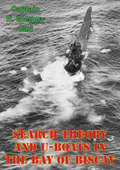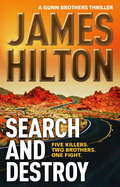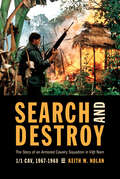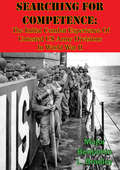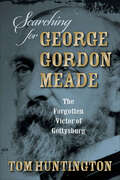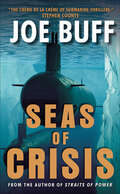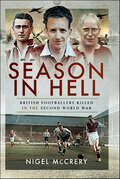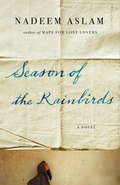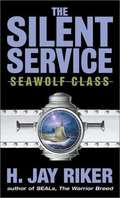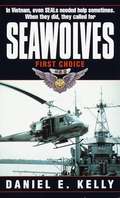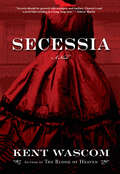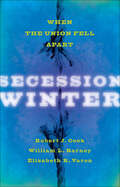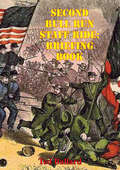- Table View
- List View
Search Theory And U-Boats In The Bay Of Biscay
by Captain R. Gregory CarlThreats to our nation's resources and forces are becoming increasingly lethal and mobile. Therefore, our ability to locate and interdict these threats is more important than ever. Search theory is one tool that is vital to countering the increasing threat. This research presents a multi-agent simulation, built around the allied search for U-boats in the Bay of Biscay during World War II, which extends several classic search theory algorithms. Comparison of techniques is based on the effectiveness of finding high-valued, mobile assets. A JAVA-based multi-agent simulation model is designed, built and tested, and used to demonstrate the existence of differing emergent behaviors between search patterns currently used by the United States military.
Search and Destroy
by Dean HughesRick Ward wants to go to war. He doesn't know why. Maybe he's running from his dad, who has an uncontrollable temper. Maybe he's running from a lost love, his high-school sweetheart, who is a stranger to him now. Or maybe he's just running -- to find himself. Desperate to experience real life, Rick enlists in the army with the Charlie Rangers, a special unit in Vietnam. They infiltrate the jungle, kill with precision, and get out quickly. Rick isn't sure he can shoot anyone, but he wants to be tested, like his heroes, Hemingway and Conrad. If he can see the heart of darkness and survive, he'll be a man -- and finally have something to write about. But as Rick discovers, war isn't what anyone -- either the protesters, the politicians, or the writers -- say it is. It's far bigger, scarier, and more complicated than anything he could ever have imagined. Dean Hughes captures the sights and sounds of war -- and the courage of a young soldier fighting to survive.
Search and Destroy
by Dean HughesRICK WARD WANTS TO GO TO WAR. And he's not sure why. Maybe he's running from his dad and his crazy temper. Maybe he's running from his girl, who seems to think he's more of a joke than a man. Or maybe he's just running -- to find himself. But after Rick ventures into the Vietnam jungle, he discovers that no one -- not protestors, politicians, or writers -- has got a clue. War is far bigger, scarier, and more complicated than anything he ever could have imagined.
Search and Destroy: A Gunn Brothers Thriller
by James HiltonBrothers Danny and Clay Gunn were brought up an ocean apart. Both served in the military, and both know how to kill, taking work as private military contractors and freelance "fixers".But when they save a woman from an assassination attempt in the Nevada desert, it is they who become targets. Vowing to protect her, they are stalked by a paramilitary team known only as The Presidents, under orders from the heart of government.Why is Andrea, a seemingly harmless journalist, the object of a search and destroy order? The only way to discover the truth--and stay alive--will be to turn the tables, and become hunters once again.
Search and Destroy: The Story of an Armored Cavalry Squadron in Viet Nam, 1/1 Cav, 1967–1968
by Keith W. NolanUsing firsthand accounts from Vietnam soldiers, this book “tells it like it is, warts and all . . . [an] honest account of a cavalry squadron’s experience” (Military Review).The 1st Squadron, 1st Cavalry Regiment, of the 1st Armored Division deployed to Vietnam from Fort Hood, Texas, in August 1967. Search and Destroy covers the 1/1’s harrowing first year and a half of combat in the war’s toughest area of operations: I Corps.The book takes readers into the savage action at infamous places like Tam Ky, the Que Son Valley, the Pineapple Forest, Hill 34, and Cigar Island, chronicling General Westmoreland’s search-and-destroy war of attrition against the Viet Cong and North Vietnamese Army. Exploring the gray areas of guerrilla war, military historian Keith Nolan details moments of great compassion toward the Vietnamese, but also eruptions of My Lai-like violence, the grimmer aspects of the 1/1’s successes. Search and Destroy is a rare account of an exemplary fighting force in action, a dramatic close-up look at the Vietnam War.“Nolan’s research, his comprehension of the political as well as the military actions, his careful concern for those who were there, and, most of all, his writing, are superb.” —Stephen Ambrose
Searching For Competence: The Initial Combat Experience Of Untested US Army Divisions In World War II
by Major Benjamin L. BradleyThe initial combat experience of the 90th Infantry Division in World War II demonstrates the leadership and training problems faced by many new divisions throughout the war.Like all newly activated World War II Divisions, the 90th had a turbulent two-year training period fraught with problems of resources and personnel. During the interwar years, the Army's readiness was allowed to stagnate below such an acceptable level that when crisis called there was little to build upon. Consequently, the larger priority of rapidly fielding 90 divisions outweighed considerations for how well those divisions were trained. Thus, the 90th Division was forced into combat by the exigencies of war with many factors working against it: untested officers, unfamiliar doctrine, limited training on advanced combat skills, and the detrimental effects of constant personnel turnover, including commanders.As the 90th went ashore on Normandy, a period of ineffectiveness ensued as soldiers were forced to learn the lessons of training under fire and unsuccessful leaders were replaced. Furthermore, the 90th Division's period of ineffectiveness seemed extraordinary because it occurred under the spotlight of the Normandy invasion where insufficient planning for the difficulties of hedgerow combat severely slowed the expected pace of advance. Undoubtedly, the performance of the 90th Division's senior leadership was abysmal, but its uncoordinated attacks were the product of training deficiencies experienced by all new divisions. Additionally, critical evaluation reveals the 90th's early contribution much higher than historically credited and far from the total failure some have labeled it.
Searching For Schindler: The true story behind the Booker Prize winning novel 'Schindler's Ark'
by Thomas KeneallyIn 1980 Thomas Keneally walked into a shop in Beverley Hills to buy a briefcase, an impulse that was to change his life. For the owner, Leopold Pfefferberg, had a story he'd been trying to interest writers and Hollywood in for years. It was the story of Oskar Schindler. In SEARCHING FOR SCHINDLER, Keneally describes how he went on to discover the full, extraordinary tale of the Aryan who risked his life to save hundreds of Jews in Nazi-occupied Poland, interviewing many of the survivors around the world. Here, for the first time, he fills in what happened to them, as well as to Schindler and his wife, in the decades after the war. And he gives a fascinating account of how his novel SCHINDLER'S ARK was published, its controversial winning of the Booker Prize, and the long road to its becoming the phenomenally successful film Schindler's List.Filled with entertaining anecdotes about the many people involved, from Steven Spielberg and Liam Neeson to Keneally's own family, SEARCHING FOR SCHINDLER gives a unique insight into the creation of a modern classic. Paying tribute to the irrepressible Poldek, it sheds renewed light on a remarkable instance of humanity amid the greatest inhumanity mankind has known.(P)2008 Bolinda Publishing Pty Ltd
Searching for George Gordon Meade: The Forgotten Victor of Gettysburg
by Tom HuntingtonA historian chronicles the life of the Union Civil War general while recounting his own unusual journey during his investigation into the past. Who was George Gordon Meade? He should be remembered as one of the Civil War&’s most important generals. Instead, history has pushed him aside. The hot-tempered Meade received command of the Union&’s dysfunctional Army of the Potomac only three days before he defeated Robert E. Lee&’s Confederates at Gettysburg. After that, Meade watched his reputation decline, thanks in part to the escape of Lee&’s army, hostility from politicians and the press, the machinations of Gen. Daniel Sickles, and the rise of Ulysses S. Grant. &“I suppose after a while,&” Meade once grumbled, &“it will be discovered I was not at Gettysburg at all.&” The Rodney Dangerfield of Civil War generals, Meade gets no respect—and author Tom Huntington wanted to find out why. In Searching for George Gordon Meade, he tells the story of the general&’s life and his participation in the Civil War&’s great engagements, from George McClellan&’s Richmond Campaign to Appomattox. Huntington also provides accounts of his own investigations of Meade&’s legacy. Along the way he hikes across battlefields, recites the names of fallen soldiers at a candlelit ceremony at Gettysburg, drinks a champagne toast at Meade&’s grave on New Year&’s Eve, and visits a severed leg, a buried arm, and a horse&’s head. The result is a quirky and compelling mash-up of history, biography, travel, and journalism that casts new light on an overlooked figure from the past. Praise for Searching for George Gordon Meade&“Unique and irresistible.&” —Harold Holzer, chairman of Lincoln Bicentennial Foundation&“Huntington&’s wry, boisterous biography-within-a-travel journal . . . strives to remake the reputation of Meade and offers a compelling new way to approach biography.&” —John G. Shelby, Meade: The Price of Command, 1863–1865 &“It&’s the rare reader who will not enjoy accompanying Huntington on his search for Meade.&” —America&’s Civil War "A refreshingly readable and well-researched book. . . . Searching for George Gordon Meade should be required reading for all those interested in Civil War history.&” —Civil War News
Searching for Stonewall Jackson: A Quest for Legacy in a Divided America
by Ben ClearyHistorian Ben Cleary takes readers beyond the legend of Stonewall Jackson and directly onto the Civil War battlefields on which he fought, and where a country once again finds itself at a crossroads. Thomas Jonathan "Stonewall" Jackson was the embodiment of Southern contradictions. He was a slave owner who fought and died, at least in part, to perpetuate slavery, yet he founded an African-American Sunday School and personally taught classes for almost a decade. For all his sternness and rigidity, Jackson was a deeply thoughtful and incredibly intelligent man. But his reputation and mythic status, then and now, was due to more than combat success. In a deeply religious age, he was revered for a piety that was far beyond the norm. How did one man meld his religion with the institution of slavery? How did he reconcile it with the business of killing, at which he so excelled?In SEARCHING FOR STONEWALL JACKSON, historian Ben Cleary examines not only Jackson's life, but his own, contemplating what it means to be a white Southerner in the 21st century. Now, as statues commemorating the Civil War are toppled and Confederate flags come down, Cleary walks the famous battlefields, following in the footsteps of his subject as he questions the legacy of Stonewall Jackson and the South's Lost Cause at a time when the contentions of politics, civil rights, and social justice are at a fever pitch.Combining nuanced, authoritative research with deeply personal stories of life in the modern American South, SEARCHING FOR STONEWALL JACKSON is a thrilling, vivid portrait of a soldier, a war, and a country still contending with its past.
Seas of Crisis: A Novel (The Jeffrey Fuller Novels #6)
by Joe Buff“Attention, all military thriller fans, report to battle stations, flank speed, superior entertainment ahead”—from the author of Straits of Power (Publishers Weekly).The Allied Powers continue their uncertain and deadly war against the Fascist Berlin–Boer Axis. The Russians remain ostensibly neutral––but their actions hint at something far more dangerous. When the U.S. discovers that the Russians are providing the Axis powers with weapons technology that could shift the balance of power, Captain Jeffrey Fuller, one of the most decorated heroes in the U.S. Navy, is called in to put an end to this potentially catastrophic Russian involvement.The plan to punish Russia is audacious. It is bold. And it is potentially suicidal. Jeffrey Fuller’s orders are to clandestinely transport commandos to Russia, where they will infiltrate a nuclear missile facility, and fire one of their weapons––at the United States. If the plan is successful, the commandos, posing as German forces, will destroy the missile as it reaches the atmosphere, creating a dramatic shift in global politics and forcing Russia to ally with the United States against Germany.Praise for the Jeffrey Fuller series“The crème de la crème of submarine thrillers.” —Stephen Coonts, New York Times–bestselling author “If you want a hair-raising trip to the bottom of the ocean, Joe Buff’s the guy to take you there.” —Patrick Robinson, New York Times–bestselling author “[Joe Buff] out-Clancys Tom Clancy.” —Kirkus Reviews
Season in Hell: British Footballers Killed in the Second World War
by Nigel McCreryProfessional football was officially suspended at the outbreak of the Second World War in September 1939. With their contracts terminated, players were free to join the Armed Forces and, by April 1940, 514 were enlisted in the Army, 84 in the RAF and 31 in the Royal Navy. Many others were involved in war work; one factory in Oldbury boasted 18 West Bromwich Albion players. Of those who joined up 80 were to die. These included English International Tom Cooper who had played for Liverpool, Derby County and Port Vale, Alan Fowler of Swindon Town who died after D Day serving with the Dorsets, and Herbie Robert of Arsenal. Many were household names as Gareth Bale and Wayne Rooney are today. In this powerful and evocative memorial book the author traces the footballing and military careers of these talented men who sacrificed all for King and Country.
Season of '42: Joe D, Teddy Ballgame, and Baseball?s Fight to Survive a Turbulent First Year of War
by Jack CavanaughBig league baseball would seem to have been a hard sell in 1942. World War II was not going well for the United States in the Pacific and not much better in Europe. Moreover, the country was in drastically short supply of ships, planes, submarines, torpedoes, and other war materials, and Uncle Sam needed men, millions of them, including those from twenty-one through thirty-five years of age who had been ordered to register for the draft, the age range of most big league baseball players. But after a "green light” from President Roosevelt, major league baseball played on in 1942 as it would throughout the war. It turned out to be an extraordinary season, too, spiced by a brash, young, and swift St. Louis Cardinal team that stunned the baseball world by winning the World Series. The 1942 season would be overshadowed by war, though, with many people wondering whether it was really all right for four hundred seemingly healthy and athletic men to play a child’s game and earn far more money than the thousands of young Americans whose lives were at risk as they fought the Germans and Japanese abroad. In Season of ’42, veteran sportswriter Jack Cavanaugh takes a look at this historic baseball season, how it was shaped and affected by the war and what, ultimately, it meant to America.
Season of the Rainbirds
by Nadeem AslamFrom the author of Maps for Lost Lovers, which was long-listed for the Man Booker Prize, Aslam's exquisite first novel, the powerful story of a secluded Pakistani village after the murder of its corrupt and prominent judge. Judge Anwar's murder sets the people of the village on edge. Their anxieties are compounded when a sack of letters, thought lost in a train crash nineteen years ago, suddenly reappears under mysterious circumstances. What secrets will these letters bring to light? Could the letters shed any light on Judge Anwar's murder? As Aslam traces the murder investigation over the next eleven days, he explores the impact that these two events have on the town's inhabitants--from Judge Anwar's surviving family to the journalist reporting on the delivery of the mail packet. With masterful attention to detail and beautiful scenes that set the rhythms of daily life in Pakistan, Aslam creates a lush and timeless world--played out against an ominous backdrop of religious tensions, assassinations, changing regimes, and faraway civil wars.
Seasons of War 2-Book Bundle: Come Looking for Me / Second Summer of War
by Cheryl CooperThis two-ebook bundle presents both books of Cheryl Cooper’s Seasons of War saga. Set against a backdrop of the naval War of 1812, the Seasons of War series revolves around the central character of 18-year-old Emily, a granddaughter of King George III and niece of the Prince Regent. Finding the royal House of Hanover dull and disagreeable to her spirited nature, she searches for the adventure and forbidden freedom. She risks a crossing of the Atlantic Ocean in June of 1813, hoping for an adventure in Canada. But she never arrives. Deadly battles on the high seas and a captain hell-bent on revengetransform her voyage into a gripping drama of treachery and tragedy. Includes: Come Looking for Me Second Summer of War
Seawolf Class (Silent Service Series #3)
by H. Jay RikerThe attack on America has changed everything. And the new war has sparked another-igniting a devastating fire that could consume the world. In the chaos of the first major conflict of the twenty-first century, an old enemy sees the opportunity to strike. Seeking to exploit America's preoccupation with its foes in the Middle East, the People's Republic of China sets out to "reclaim" by force the territories it considers its own: the Spratly Islands in the South China Sea... and Taiwan. China's arsenal is awesome and deadly, including a pair of Akula nuclear-powered subs purchased from a cash-hungry Russia. As Chinese missiles fly across the Straits of Taiwan, the casualties mount at an alarming rate-with American servicemen numbered among the many dead. World War Three now seems inevitable. And the fate of the Earth suddenly rests with the commander and crew of the U.S.S. Seawolf, lead boat of America's newest class of ultra-silent attack submarines. For this battle can only be won beneath the surface of a turbulent sea-where the enemy rules in firepower and numbers... and will not relent, even at the cost of the future.
Seawolves: First Choice
by Daniel E. KellyThey called themselves Seawolves . . . The men of SEALs, PBRs, and SF called them saviors . . . Created in 1967, the HAL-3 helicopter squadron--aka Seawolves--provided quick-reaction close air support to SEALs, PBR River Rats, and Special Forces advisers and their troops. During the five years of the unit's existence, the seven detachments of Seawolves amassed stunning statistics: 78,000 missions, 8,200 enemy kills, 8,700 sampans sunk, and 9,500 structures destroyed. These 200 men collected a total of 17,339 medals. This is the story of one of those men. . . . Taking enemy fire while braced against the rocket pod of a Huey gunship and shooting an M-60 freehand in 110 mph winds was just part of Dan Kelly's job in Vietnam. As a gunner in the all-volunteer Seawolves, he served with distinction until three bullets bought him a trip home. Here is his amazing story of the Seawolves--a harrowing tale of unsung heroism and undaunted courage in combat.
Sebastian
by Christoph FischerSebastian è la storia di un giovane che, a causa di uno sfortunato incidente, gli viene amputata una gamba poco prima della prima guerra mondiale. Quando suo padre viene arruolato in guerra, tocca a lui gestire il negozio di alimentari di famiglia a Vienna, crescere nelle sue responsabilità, sopportare la perdita e l'incertezza, e sperare di trovare l'amore. Sebastian Schreiber, la sua famiglia allargata, i loro amici e i dipendenti del negozio sperimentano i "giorni d'oro" della Vienna prebellica, il periodo della guerra e la fine della monarchia, mentre cercano di guadagnarsi da vivere e di preservare ciò che hanno di più caro. Fischer descrive in modo convincente la vita a Vienna durante gli anni della guerra; come ha colpito la gente in un luogo altrimenti sicuro e prospero, l'inizio della fine del sistema monarchico, l'arrivo di pensieri e tendenze moderne, il sistema di classe viennese e la fine di un'epoca.
Sebastian: El paso a la adultez de un joven de Viena antes, durante y después de la I Guerra Mundial
by Christoph FischerSebastian es la historia de un joven que, debido a un desafortunado incidente, le amputan la pierna poco antes de la I Guerra Mundial. Así, cuando su padre es llamado a filas para la guerra, le toca a él llevar la tienda familiar de Viena, asumir sus responsabilidades, soportar la pérdida y la incertidumbre, y con suerte, encontrar el amor. Sebastian Schreiber, su familia, sus amigos y los empleados de la tienda experimentan los "días dorados" de la Viena de preguerra, el tiempo de la guerra y el fin de la monarquía, mientras intentan ganarse la vida y conservar lo que más aprecian. Fischer describe de forma convincente la vida en Viena durante los años de la guerra; cómo afectó a la gente en un lugar por lo demás seguro y próspero, el principio del fin del sistema monárquico, la llegada de los pensamientos y tendencias modernas, el sistema de clases vienés y el fin de una era.
Secessia: A Novel
by Kent WascomThe acclaimed author of The Blood of Heaven shares “a vivid portrait of 1862 New Orleans” as Union soldiers take over in this panoramic Civil War novel (Ron Charles, Washington Post).The largest city in the ill-starred confederacy has fallen under the soon-to-be-infamous General Benjamin “the Beast” Butler. And when twelve-year-old Joseph Woolsack disappears from his home, he draws his mother, Elise—a mixed-race woman passing for white—into a dark new world.Joseph grapples with his father’s legacy of violence and his own growing sentiment for Cuban exile Marina Fandal, the only survivor of a shipwreck that claimed the lives of her parents. Meanwhile, Elise struggles to keep hold of her sanity, her son and her own precarious station. But she soon encounters a troubling figure from her past, a man who is deeply mired in the intrigue surrounding the city’s occupation.Alternating between the perspectives of five characters, Secessia weaves a tapestry of ravenous greed and malformed love, of slavery and desperation, set within the baroque melting-pot that is New Orleans. A Gothic tableaux vivant of epic scope and intimate horror, Secessia is the netherworld reflection of the conflict between north and south.
Secession Winter: When the Union Fell Apart (The Marcus Cunliffe Lecture Series)
by William L. Barney Robert J. Cook Elizabeth R. VaronWhat prompted southern secession in the winter of 1860–61 and why did secession culminate in the American Civil War?Politicians and opinion leaders on both sides of the Mason-Dixon line struggled to formulate coherent responses to the secession of the deep South states. The Confederate attack on Fort Sumter in mid-April 1861 triggered civil war and the loss of four upper South states from the Union. The essays by three senior historians in Secession Winter explore the robust debates that preceded these events.For five months in the winter of 1860–1861, Americans did not know for certain that civil war was upon them. Some hoped for a compromise; others wanted a fight. Many struggled to understand what was happening to their country. Robert J. Cook, William L. Barney, and Elizabeth R. Varon take approaches to this period that combine political, economic, and social-cultural lines of analysis. Rather than focus on whether civil war was inevitable, they look at the political process of secession and find multiple internal divisions—political parties, whites and nonwhites, elites and masses, men and women. Even individual northerners and southerners suffered inner conflicts. The authors include the voices of Unionists and Whig party moderates who had much to lose and upcountry folk who owned no slaves and did not particularly like those who did. Barney contends that white southerners were driven to secede by anxiety and guilt over slavery. Varon takes a new look at Robert E. Lee's decision to join the Confederacy. Cook argues that both northern and southern politicians claimed the rightness of their cause by constructing selective narratives of historical grievances. Secession Winter explores the fact of contingency and reminds readers and students that nothing was foreordained.
Second Bull Run Staff Ride: Briefing Book [Illustrated Edition]
by Ted BallardContains more than 20 maps, diagrams and illustrationsJackson's march into the rear of Pope's army opened the Battle of Second Manassas. a battle which has many lessons worthy of study; the deep strike, unity of command, intelligence, logistics and importance of terrain, just to name a few.Accordingly, the purpose of the Manassas staff ride is to learn lessons of the past by analyzing this battle through the eyes of the men who were there, both leaders and rank and file soldiers. Hopefully, the actions or inactions of certain Civil War commanders and the reactions of their troops will allow us to gain insights into decision-making and the human condition during battle.
Second Chance Alaska (A Wild Coast Novel)
by Jennifer SnowWill they risk taking the plunge from friendship to forever? Oliver Klein&’s wife and oldest daughter were lost at sea—a tragic mystery that left the small coastal town of Port Serenity reeling. Three years later, surrounded by the wild Alaskan waters that claimed them, the grieving lighthouse keeper is still haunted by their disappearance. Oliver knows he should move on for the sake of his younger daughter, Tess, but he isn&’t so sure he&’s ready to love again. Carly Walters knew losing her best friend, Alison, would break her heart—yet she never expected Alison&’s husband might be the one to mend it. The more her life intertwines with Oliver&’s, the harder she falls for him…and the guiltier she feels. Amid the rush of the summer tourist season, can Carly and Oliver finally accept the past while looking forward to a bright future…together?Bonus Novella In Jennifer Snow's Love in the Alaskan Wilds, Anna Armos hires pilot Dwayne Madden to help her find the wreckage of a crashed plane that could lead to a lost fortune. But as they journey into the remote Alaskan backwoods, Anna has to trust her daredevil pilot with the truth: she's not just looking for treasure—she's searching for answers!A Wild Coast NovelBook 1: Sweet Home AlaskaBook 2: Alaska for ChristmasBook 3: Second Chance Alaska
Second Chance Love: A Clean Romance (Veterans' Road #5)
by Cheryl HarperFriends reuniteFor a second chance…at love Air force veteran Marcus Bryant lost his best friend, Cassie Brooks, when he joined the military. Now she&’s a columnist after a story—and reconnecting with Marcus will help her get it. Decorating for their high school reunion will give her the inside scoop. And the advertising will help Marcus&’s new landscaping business. But could the fresh start he&’s craving most be with Cassie?USA TODAY Bestselling AuthorVeterans' RoadBook 1: A Soldier SavedBook 2: The Dalmatian DilemmaBook 3: The Doctor and the MatchmakerBook 4: Her Holiday ReunionBook 5: Second Chance Love
Second Chance with Her Army Doc (Harlequin Lp Medical Ser.)
by Dianne DrakeAn injured army medic is reunited with the beautiful doctor he let get away in this medical romance. Can a chance reunion . . . rekindle an old flame? Heart surgeon Sloane Manning and army doc Carter Holmes were the perfect couple. Until Carter walked away, leaving Sloane heartbroken. Determined to finally move on, Sloane heads off for a desert vacation, only to find Carter’s there, too! He’s still as ruggedly gorgeous and irresistibly charming as she remembers, but there’s a pain in his eyes Sloane must uncover before they can recapture what they once had . . .
Second Chance with Her Soldier
by Barbara HannayOne last chance? Returning from the front lines, Corporal Joe Madden clutches his divorce papers. After a series of heartbreaking fertility problems, he knows his once perfect marriage is set for the final curtain. It might be three years since Ellie has seen her husband, yet his power to make her heart race is just as strong. But he's only passing through, and all that's needed is her signature.... Until the rain begins to fall on Karinya Station and there is nowhere to escape. Could a Christmas peace treaty and a magical few days bring the sparkle back into their marriage?
